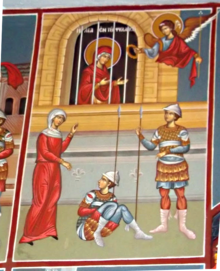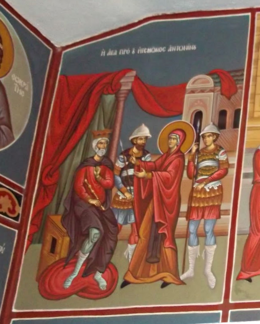Paraskeva of Rome


holds the martyr's cross in her right hand and her head in the left
The Paraskeva von Rom (also Paraskevi von Rom ; * around 117 near Rome ; † between 160 and 170 in Athens ) was a young Christian who martyred under the Roman emperors Antoninus Pius and Mark Aurel and finally by the Roman governor Tarasius near by Thessaloniki was beheaded. The Martyrologium Romanum does not know them. She is venerated by the Byzantine Orthodox Churches on July 26th. She is considered the patron saint of the blind.
The name
The name Paraskeva ( Greek : Παρασκευή) literally means “preparation” as the day of preparation for the weekend, the Sabbath , ie “Friday”.
hagiography
Paraskeva was the daughter of the rich and very pious Christian Greeks Agathon and Politeia and was born after many childless years on the 6th day of the week (Friday) at 117 at the time of the Roman Emperor Hadrian in a suburb of Rome, where she was in gratitude to Christ grew up in great love for Him. From an early age she devoted herself to the Holy Scriptures, the meditation of the Word of God and converted many people to the faith of Christ. It is said to have been very beautiful and to have been wooed a lot. Apparently she turned down all offers and is said to have insisted on living virginally as the bride of Christ.
When Paraskeva was 20 years old, her parents died, and she inherited a great fortune. She sold all of her worldly goods and distributed most of her money among the poor. With the rest she contributed to the treasury of a Christian community in Rome that supported a house for virgins and widows (monastery) who had dedicated their lives to the teachings of Christianity . However, these women had strayed far from the word of the gospel, and as a result Paraskeva stayed in this house for many years teaching them the true meaning of Christianity.
At the age of 30, she left Rome and traveled to cities and towns, preaching Christ and the gospel in public. This happened at the time when Jews and Romans persecuted the new religion with the greatest sharpness.
Persecution under Antoninus Pius
Back in Rome, Paraskeva was reported by a Jew as hostile to the official religion . Antoninus Pius summoned her to his palace to question her. Attracted by her beauty and humility, Antoninus Pius is said to have tried to use kind words to induce her to deny her faith. Apparently he promised to marry her and make her an empress. Annoyed by her refusal, the emperor had a nailed, glowing iron metal helmet placed on her indomitable head without harming her. When the crowd of Gentiles and Jews around saw this miracle, many converted to Christianity, who had Emperor Antoninus Pius killed or exiled. Back in prison, an angel appeared to Paraskeva who comforted and strengthened her. The next day Paraskeva was brought before the emperor again and interrogated. Her firm belief in Jesus Christ made Antoninus Pius white hot, so that he ordered her to be hung by her hair and torched and burned her armpits and other limbs, which remained unsuccessful. When the emperor saw that he could not even bend her mind through this torture, he ordered her to be thrown into a cauldron of boiling pitch and sulfur . When the soldiers carried out this order, however, Paraskeva was unharmed. Annoyed, Antoninus thought that Paraskeva would use magic to keep the contents cool, but she told him that he could test it. So she took some of the boiling liquid and threw it into the emperor's face. The liquid burned the eyes of the emperor, who went blind and cried out for mercy. Paraskeva got out of the kettle, went to Antoninus Pius and told him that only the Christian God could heal him. Antoninus Pius immediately regained his eyesight. This miracle moved Antoninus Pius to stop persecuting Christians until his death in 161.
Persecution under Marcus Aurelius
Paraskeva went on with greater zeal to accomplish her apostolic mission. After the death of Antoninus Pius, Mark Aurel succeeded him to the throne (161-180). During his reign he was confronted with the Antonine Plague , in which many people died. Once again the Christians were accused and persecuted . The emperor was forced to change the laws dealing with "non-believers". One day Paraskeva was captured in a city ruled by a man named Asklepios. When she refused to sacrifice to the pagan gods, she was thrown into a pit with a large snake. Paraskeva made the sign of the cross, and the serpent did not hurt her. Asklepios realized that Paraskeva was protected by an extraordinary power and released her.
As a traveling preacher Paraskeva also reached today's Greece . She was arrested by pagans near Thessaloniki , brought before the Roman governor Tarasius and interrogated by him. Like Antoninus Pius, he ordered his soldiers to boil a kettle with oil and pitch and put Paraskeva in it. Again, nothing happened and many of the audience converted to Christianity. Tarasius, who believed that Paraskeva was a witch, ordered her hands and feet to be handcuffed and whipped until she wanted to sacrifice to the gods or was sentenced to death. The soldiers carried out his order without any result. Paraskeva did not bow. Seeing her steadfastness, the governor had her thrown into prison, where her hands and feet were nailed and a heavy stone was placed on her chest. That night, however, Jesus Christ appeared to her in a company of angels, who comforted her, healed her wounds and freed her from her chains.
The next morning Paraskeva was willingly led to the Temple of Apollo . Upon entering the temple, Paraskeva raised her hand and crossed herself. Suddenly a loud noise was heard and all the statues in the temple fell from their pedestals and broke with a great clang. The priests and idolaters dragged them away from the altar, beat them, and threw them out of the temple. The priests asked Tarasius to kill Paraskeva. She was found guilty and sentenced to death by beheading.
After the sentence was pronounced, the soldiers took Paraskeva outside of town to carry out the sentence. When they got there, Paraskeva asked for some time to pray, which she was allowed to do. After her prayer, she bowed her head and the soldiers cut him off with the sword. Her commemoration will be celebrated in the Byzantine Orthodox churches on July 26th.
wonder
Many healing miracles are ascribed to the Paraskeva. Tradition has it that those who came into contact with their deep faith were miraculously healed: the cripples could walk, the demonized regained their health and the sterile became pregnant. Above all else, she miraculously healed the emperor Antoninus Pius from his blindness while standing in the heated kettle. The merciful affection for her tormentor made her a holy intercessor for the healing of eye diseases.
presentation
Paraskeva is the patron saint of the blind and holds a cross, symbol of martyrdom , in her right hand and her own head in her left hand . Paraskeva is also depicted with two eyes in a bowl that she holds in her left hand or with a large cauldron under her.
The suburb of Agia Paraskevi in Athens was named after this saint .
See also
Web links
- Paraskevi. In: Orthodoxwiki.org. Retrieved September 22, 2017 (English).
Individual evidence
- ^ JE Stadler, FJ Heim and JN Ginal: Santa Parasceve . In: Complete Lexicon of Saints . tape 4 . Augsburg 1875, p. 677 .
- ↑ Santa Parasceve, martire. In: Calendariobizantino.it. Retrieved September 20, 2017 (Italian).
- ↑ a b c d e Saint Paraskevi. Retrieved September 20, 2017 .
- ↑ a b c d e f g Paraskevi. Retrieved September 20, 2017 (English).
- ↑ Santa Veneranda Parasceve. Retrieved September 20, 2017 (Italian).
- ^ Saint Parasceva of Rome. In: Catholicsaints.info. Accessed September 21, 2017 .
- ↑ Gaetano Passarelli: Le icone e le radici. Le icone di Villa Badessa . Fabiani Industria Poligrafica, Sambuceto 2006, p. 93 (Italian).
| personal data | |
|---|---|
| SURNAME | Paraskeva of Rome |
| ALTERNATIVE NAMES | Paraskevi of Rome |
| BRIEF DESCRIPTION | Martyr and saint |
| DATE OF BIRTH | at 117 |
| PLACE OF BIRTH | near Rome |
| DATE OF DEATH | at 170 |
| Place of death | Athens |





